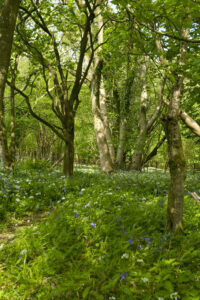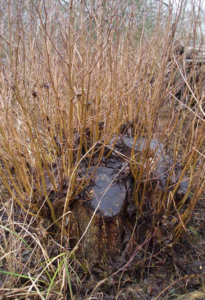Large areas of woodland span the Chase & Chalke landscape Area and their beauty can be appreciated all year round, however a marked decline in active woodland management has led to consequences for wildlife and the landscape.
Why is Woodland Management Important?
Woodlands require active management to ensure a wide range of tree, plant and animal life can thrive there.
This management also helps in combating the spread of pests and illnesses, and produces healthier trees.

Active management of more woodlands in the area is key to the quality of biodiversity and the structure of the character of this landscape. Targeted woodland work may also aid iconic key species associated with ancient woodland and hazel coppice, like dormice.
Why Remove Trees?
By removing unhealthy trees, we create space for the healthier ones to grow strong with greater access to nutrients. Removing sickly trees also reduces the canopy, which allows sunlight to filter down to the forest floor.
This sunlight allows a greater variety of plants to grow on the forest floor, which in turn supports a greater diversity of insect and animal life.

Planting Saplings
About 10% of saplings planted are lost through natural causes, so extra saplings are planted to take this into account.
After 10 – 15 years, the trees are thinned by removing the less healthy ones. This gives the stronger saplings greater access to nutrients and space to grow. The increased sunlight from the thinned canopy allows natural germination of fallen seeds to occur too, letting the forest regenerate itself.

What is Coppicing?
Coppicing is a traditional method of woodland management in which young tree stems are repeatedly cut down to near ground level to form a stool or a stump, which encourages the tree to put out many new shoots.

After a number of years the new young tree stems are harvested and the cycle begins again.
The widespread and long-term practice of coppicing is an industry that remains of special importance to southern England.
Typically a coppiced woodland is harvested in sections on a rotation, and this way a crop is available each year within a woodland. Coppicing provides a rich variety of habitats as the woodland always has a range of different-aged coppice growing in it.

Different species of tree have different lengths of growth cycles, for example, birch can be coppiced on a three or four year cycle, whereas oak can be coppiced on a 50 year cycle for poles and firewood.
Interestingly, trees that are being coppiced cannot die of old age. The process maintains the tree at a juvenile stage which allows them to reach immense ages. The age of stools can be estimated from their diameter, and some are so large (approx. 5.5 metres) that they are thought to have been continually coppiced for centuries.
The Benefits of a Healthy Woodland
Economic benefits
A healthy woodland creates economic benefits as the wood cut down can be used for timber and fuel.
This is a sustainable and ethical way to produce timber. Proper woodland management includes regenerating the trees that are cut and managing the balance of the ecology. This is in contrast to unhealthy deforestation we see today taking place around the world, in which mass amounts of trees are removed.
Well-seasoned good quality dry wood is a low cost and efficient fuel, which produces less harmful emissions than other fuel sources.
Social and Community Benefits
The social and community benefits gained from a healthy woodland are endless.
Managed woodlands are easy to access and safer to visit than unmanaged sites. They provide opportunities for recreation, mental health improvement and connecting with nature. They serve as educational sites for learning about woodlands and biodiversity. They improve the quality of life for nearby residents, and add beauty to the landscape. If the woodlands economic benefits are fostered, they provide employment and trade opportunities for local communities.
Environmental Benefits
A well managed woodland produces far greater biodiversity than unmanaged woodlands.
The removal of unhealthy trees reduces the spread of disease and allows stronger trees to mature. A mature Oak tree helps to support around 500 species of flora and fauna. Healthy woodlands create better air quality and have a cooling effect in hot temperatures. Timber produced from a healthy woodland can be worked into wooden products and items that are better for the environment than plastic or other materials.
A Decline in Rural Woodland Skills
As our community has seen a decline in rural skills, and a decreased reliance on woodland for our economy, often these woodlands are not actively managed. This causes consequences for the landscape and the wildlife and biodiversity of the wood.
The Wonderful Woodlands project intends to bring back into management ‘showcase’ woodlands to demonstrate the benefits to wildlife and game as well as add aesthetic and economic value.
Working with woodland owners, local communities and newly trained individuals we want to provide a catalyst to improve the condition of wooded areas, increase knowledge of their importance, and increase woodland management skills and capacity to support this across this wonderful area.



